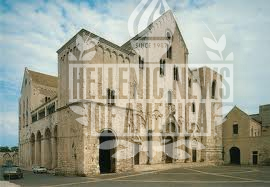
Catherine Tsounis
221 – 34 58 Avenue
Oakland Gardens, New York 11364
917 596-0367
by Andreas George, Seaburn
The detailed investigation of the existence of St. Nicholas of Myra by international scientist Andreas George is the final word on the subject. His scientific examination of sources and historical sites disproves the 1970’s action of the Vatican, demoting St. Nicholas as a major saint or characterization as a mythological figure.
The life of St. Nicholas in Myra, modern Demre in Asia Minor, Turkey is not widely known. Mr. George describes his life in detail referring to many sources. His major source is Michael the Archimandrite of 842 A.D., Symeon the Translator, written five centuries after St. Nicholas’s death in 335 A.D. and others. The problem with his research, he admits is that it is not based on primary sources. There are no primary sources describing his personal life, only secondary sources centuries after St. Nicholas’ death. Alexander the Great’s life is based on the same secondary sources.
St. Nicholas’ ancestors were Greeks, descendants of Alexander the Great’s colonists or of Cretans. The author believes St. Nicholas’ ancestors were most likely from Crete, because of similar customs and traditions with the Greek island. Modern Greek sources on the Greek Cities of Asia Minor show that the Greek communities along the Asia Minor coast had up to 50 percent Cretans until the 1922 Catastrophe. Their dialect and customs were also similar to the Cretan culture. Mr. George’s research added information that St. Nicholas spent time in Cyprus through his visits to monasteries and study of Greek sources. His translations into English of these facts are invaluable to a serious reader.
The author explains that the lack of written information on St. Nicholas comes from the following historical events: suppression of information by Julius the Apostate; destruction of church documents by the 9th century Iconoclastic movement, the Crusaders, Moslems, Arab pirates and the Protestant Reformation. The 11th and 12th chapters provide facts that will open the reader’s eyes on the real St. Nicholas of Myra. The author’s pilgrimage to Demre in Turkey (Ancient Myra) shows the rediscovery of the Christian homeland.
I personally was fascinated by his portrayal of Bari, Italy as a Byzantine stronghold. In Modern Greek history books, the fall of Byzantine Bari to the Normans was a major catastrophe listed on every timeline. The relics of St. Nicholas were sent to Bari in the 11th century to save them from the Moslem invaders of Myra, Asia Minor. The history and the building of the Basilica of St. Nicholas of Bari give one a total view of this center of Byzantium in the west. The glory of Bari, unknown to many makes chapter 6 and 7 of major interest to all whose ancestors were from this major trade center.
What did St. Nicholas look like? Unknown to many, the author describe3s the reconstruction of the saint’s bones in the 1950’s by Anatomy Professor L. Martino of the University of Bari and two doctors. Their scientific investigation showed the bones were of a man 1.67 meters (about 5 feet and six inches) tall with a broad forehead and large sunken eyes. This description is similar to the facial characteristics in Byzantine icons. Professor Martino explained the bones belonged to a Mediterranean, more likely a Greek from Asia Minor.
Mr. Andreas George is a scholar, having written scientific papers on radioactivity and radiation exposure. His background as a scientific investigator and author makes this one of the finest books written on St. Nicholas of Myra. The book is available at Seaburn.







